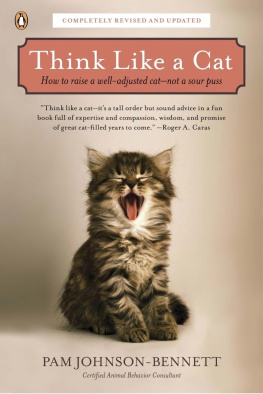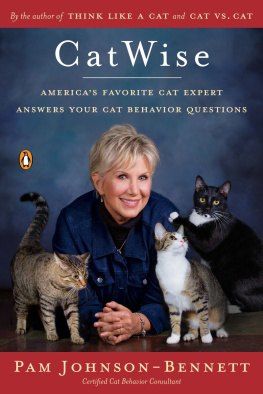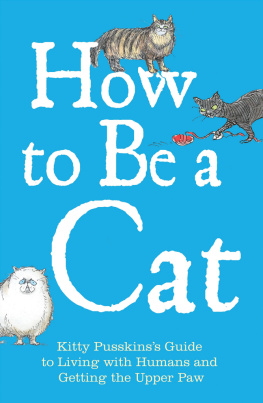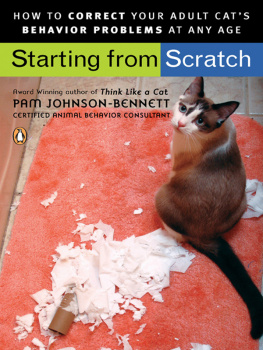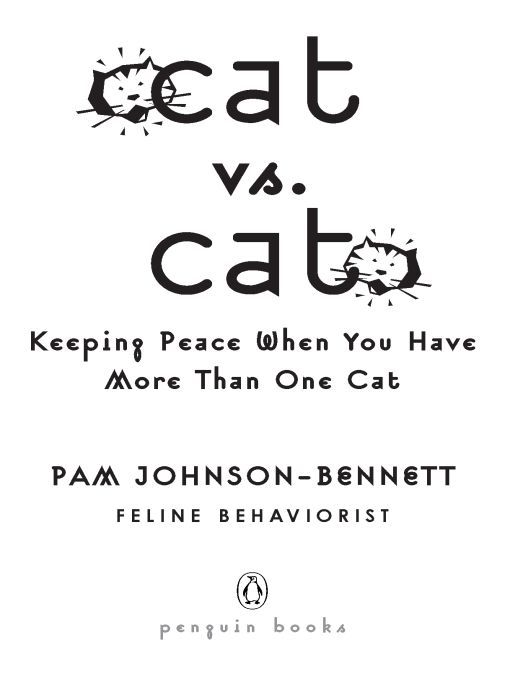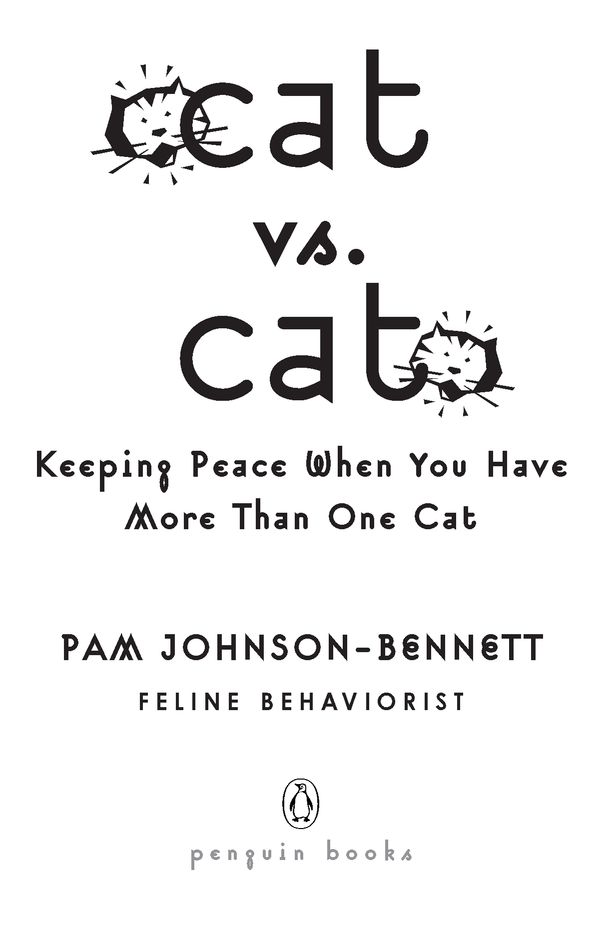Table of Contents
PENGUIN BOOKS cat vs.cat
Nationally renowned feline behaviorist Pam Johnson-Bennett is the author of five other award-winning books on cat behavior, including Think Like a Cat: How to Raise a Well-Adjusted Cat Not a Sour Puss, as well as an award-winning columnist. Pam is the resident cat expert at the popular Web site ivillage.com and was the behavior columnist for the Internet magazine The Daily Cat for a number of years. She has also written numerous behavioral articles for national magazines and was previously the behavior columnist for Cats magazine.
In addition to her busy private veterinarian-referred behavior practice, Pam is a popular guest on national TV and radio, and has spoken on the subject of behavior at veterinary conferences and animal welfare organizations.
Pam and her husband live in Tennessee with their daughter. They share their home with three cats, Albie, Mary Margaret, and Bebe. Albie had final approval on this book.
Scott, you make dreams come true.
This book is for you and Gracie,
and all of the cats waiting for their families at
the Rainbow Bridge.
ACKNOWLEDGMENTS
My biggest thank-you has to go to the cats who have trusted me and allowed me into their world all of these years. Every day they give me a renewed appreciation of their beauty, loyalty, grace, intelligence, and endless patience.
Thanks to Ellen Pryor; my agent, Linda Roghaar; my editor, Claire Hunsaker; and all of the wonderful people at Penguin Books. Steve Dale, thank you for being such a dear friend. The animals in our world are so lucky to have you watching out for them. Thanks to my home away from homeivillage.com and the amazing people who help keep the message board and chat room running smoothly. My CLs on that board are the best, and I must give a special thanks to Barb.
Introduction
Cats are the most popular pets in the United States, and so many of us share our lives with more than one. These beautiful creatures are clean, quiet, able to live indoors exclusively, and naturally take to eliminating in a litter box. Its so easy for many people to want to make the progression from one cat to two, three, or more.
However it has come to be, you are truly blessed to share your home and your heart with cats. There are so many joys in having more than one. Unfortunately, though, multicat families also face some unique problems. While any cat can experience a behavior problem, it certainly can become magnified in a multicat home. Heck, it can be harder just trying to figure out which cat is causing the problem.
I make many of my house calls to multicat homes, and the problem is often due to intercat relationship issues. Maybe the owner didnt know how to properly introduce the cats, or maybe the cats are jockeying for a better position in the hierarchy, or maybe territorial disagreements have led to a litter box problem. All too often, owners dont know enough about how cats live together, so they dont understand how to create an environment that inspires peaceful coexistence. We love cats so much, but we dont realize that they are essentially territorial. When we ask them to live close together, they have less personal space, and a smaller territory causes them a lot of stress. Overcrowding can create tremendous anxiety and turn a happy home into a war zone. Cats give us so much and we have a responsibility to create an environment in which everyone can feel happy, safe, and secure.
This book will teach you how to avoid multicat household behavior problems and will also help if youre in the middle of a crisis right now. Ive written this to be a companion to my book on general cat care and training, Think Like a Cat. If youre a first-time cat parent or considering becoming one, I recommend that you read Think Like a Cat to get a good foundation in the basics of care and training. Cat Vs. Cat will then provide you with valuable insight into how cats communicate both with humans and other cats. When you learn the whys behind behavior, youll better understand what cats need from you, their environment, and each other. That way, if you decide to join the family of multicat parents, youll be able to avoid many behavior problems and simply enjoy those fuzzy bundles of love.
If youre a seasoned cat parent, this book will help you sharpen your detective skills and solve current problems. Youll be able to take a step back to observe your multicat environment in a more objective way, figure out the causes, and then map out a behavior modification plan. Whether your situation just needs a little tweaking or a major overhaul, youll find techniques in this book to get you and your cats back on track.
Id also like to address one issue right up front because the rest of this book is absolutely secondary to this: You must spay and neuter your cats. Intact cats cannot coexist peacefully. Intact males will definitely spray and fight. If allowed outdoors, intact males will roam, fight, and indiscriminately mate. Unspayed females will call repeatedly, attract unwanted cats into your yard, and constantly try to escape out the door. Intact animals are also at a higher risk of developing certain types of cancers. Cats who are not spayed or neutered are ruled by their hormones. They dont make good pets by themselves and are impossible to maintain in a multicat home.
I am the parent of three cats. Albie I adopted as a very young kitten and Mary Margaret and Bebe came into my life as ferals. Bebe needs a great deal of personal space in order to feel secure. Ive set up my home to allow for that so she has special places she can go when she needs alone time. All of my cats are spayed and neutered and live exclusively indoors. By better understanding what they need and how to create a secure and enriching environment, we all live together in peace. When I come home and find a couple of the kitties curled up together, it just melts my heart. My wish is that you are able to enjoy many of those heart-melting moments as well.
Understanding the Feline Hierarchy
You may look at your multicat household as one happy family; you love your cats equally and feel there shouldnt be any reason for fighting or squabbling. In reality, though, your cats dont view each other as equals, nor should they. Whether you have two cats or twenty, there is a pecking order. It may bother you to think that a few cats reign supreme over others, but hierarchy is necessary in feline society. In a free-roaming situation, it prevents overcrowding of the colony and gives cats a sense of order and security.
CATS ARE SOCIAL CREATURES
Many people believe cats to be solitary creatures. That mistaken belief in part stems from the fact that cats hunt alone. As a small animal, a cat hunts small prey, which isnt much of a motivator for cooperation. This makes the cat look all the more like a loner.
Another behavior that adds to the cats mistakenly labeled reputation as asocial is his territorial instinct. One example of how we recognize dogs as social creatures is because existing canine households will often easily accept a new puppy. When cat owners think of adding another kitty, visions of hissing, scratching, fights, and, in general, disaster, come to mind. This hardly inspires one to label a cat as


